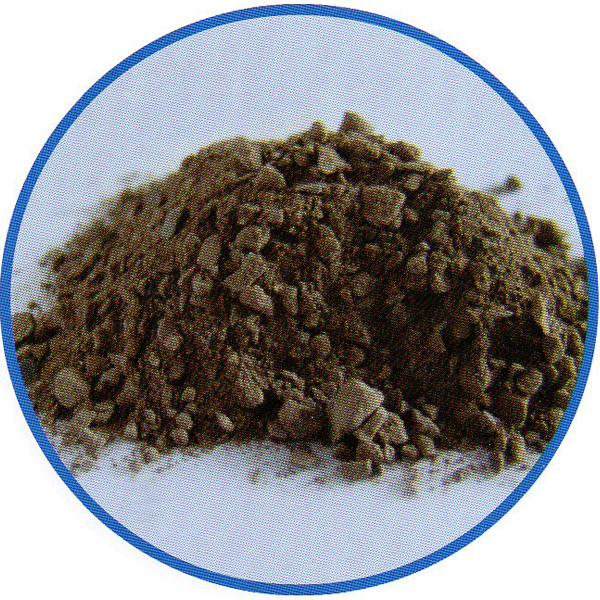Refractory construction rules for the overall lining of the blast furnace are collected and compiled by the refractory manufacturer. Light burnt powder
1. Furnace foundation construction:
First, draw a circle with the required radius for masonry on the foundation concrete of the blast furnace with the center of the flange on the top of the blast furnace as the center, as the masonry reference line for the clay brick masonry of the furnace foundation. Then, a layer of rigid plastic mortar about 30mm thick was laid, and the blast furnace clay bricks were laid. After the furnace base clay brick masonry is air-laid with 3 layers, the carbonaceous ramming material is used for construction ramming. Then tie up the steel bars, and then construct the refractory concrete to complete the masonry of the blast furnace foundation pier.
2. Construction of the bottom water cooling pipe:
Lay about 30mm thick rigid-plastic mortar on the blast furnace foundation pier, and spray heavy refractory spray paint on the water-cooled pipe. After checking the construction quality, the welding installation of the furnace bottom sealing plate is carried out, and the installation quality is checked and confirmed after completion.
3. Pressure grouting of furnace floor:
The grouting hole reserved for the furnace bottom sealing plate is welded to the short grouting pipe, and the furnace bottom grouting is started. After the grouting is completed, the control grid is welded and installed. After the control grid is installed, check and confirm its installation quality.
4. Furnace bottom leveling construction:
Clean the construction area at the bottom of the furnace, pave the ramming material in layers, start ramming from the center to both sides, when the last layer is ramming, scrape the height of the paving material to ensure that it is higher after the ramming The top surface of the flat steel is about 3~5mm, and the construction surface is leveled with a shovel.

5. Cooling stave (board) jointing:
Use sealing iron sheet to joint the vertical seams and circular seams of the cooling stave: close the sealing iron sheet to the back of the cooling stave, and tie it firmly with iron wire and bamboo sticks. When jointing, it should be carried out in the order from top to bottom and from inside to outside.
6. Furnace bottom masonry:
Key points of microporous roasting carbon block masonry:
Rotate 38° clockwise from the center of the blast furnace to cast the centerline of the brickwork. Then lay the carbon blocks used for support in an orderly dry pendulum in the furnace, leaving a gap of 2mm for each carbon block. After the laying is complete, fix the wooden support frame, check the quality and start the masonry. Lift the center carbon block to the center of the furnace body so that the upper and lower center lines of the carbon block coincide with the center line of the brickwork at the bottom of the furnace, and then fix the two carbon blocks at both ends of the center row at the specified position in the same way. Stagger the center line of the central row of carbon blocks and re-pull the line so that the second row of carbon blocks on one side is laid on the basis of the side line of the central row of carbon blocks. The wooden support is also suitable for fixing.
Take the second row of carbon blocks as the guide surface to build the center of the carbon blocks, starting from the center to both ends. When five or so carbon blocks in the center row have been built, use jacks from both ends to push to the center at the same time, and all vertical seams can be topped to the required size. When using the jack, the force on both ends should be even to avoid dislocation and displacement of the brick body. When the four rows of charcoal bricks in one row are completed according to the masonry requirements, the middle support frame is removed, and both sides are simultaneously masonry. After the whole layer of carbon block is built, the rubber is laid, and the carbon ramming material is rammed layer by layer to remove the debris in the joint. After the construction is completed, clean the furnace and check the construction quality. Then carry out the construction of the upper layer, and rotate the center lines of the upper and lower layers by 30°.
7. Hearth masonry:
Pull the line from the center of the furnace bottom to draw the masonry sideline of the annular microporous carbon block. First lay out the entire ring of carbon blocks according to the actual radius of the wire (the first three blocks are not swayed, and are used as the roof support for the subsequent carbon blocks), and then build from the starting position. When each block is built, measure Its radius, centripetal degree and elevation should be adjusted in time when laying; every 5-6 pieces of carbon blocks are built, jacks and wooden wedges must be used to tighten the blocks. It is necessary to confirm whether the center line and the carbon block pre-masonry center line overlap every 90° direction, and make timely adjustments. After the whole ring of carbon blocks is built, the wooden wedges are tightened to carry out the construction of the carbon ramming material.
When laying ceramic coasters, place and fix the guide square wood along the bricklaying line at the bottom of the furnace, and then start to build the ceramic coaster bottom bricks, starting from the middle of the semicircle on one side to the two sides in order. When the thickness of 6 rows of bricks is reached, the guide square timber is removed, and both sides start to build simultaneously. After the bottom layer of the ceramic cup is built with bricks, the furnace is cleaned, and the gap between the bottom brick of the ceramic cup and the carbon block is filled with carbon mortar. After the whole floor of the furnace bottom is constructed and leveled, the upper floor is built, and the center lines of the upper and lower floors are rotated by 30°.
8. Tiekou Center:
The hearth ceramic cup wall bricks and the ring-shaped carbon block are built alternately, from inside to outside, to ensure that the cup wall bricks are layered with the adjacent ring-shaped carbon blocks. When building the iron mouth area, the composite bricks should be laid first, and then the carbon blocks in other parts should be laid.
9. Masonry in the tuyere area:
According to the requirements of the horizontal center of the air outlet, the radial center and the radius, several groups of adjacent composite bricks are laid with dry pendulum, and expansion joints of appropriate size are reserved. Starting from the radial center of the two air outlets, the masonry is built on both sides, from the outer ring brick to the inner ring brick. The construction of the ramming material on the back of the combined brick and the masonry of the brick layer shall be carried out alternately.
10. Masonry of furnace belly, furnace waist and furnace body:
The microporous fired aluminum-carbon bricks and phosphate-impregnated clay bricks are close to the cooling stave for masonry, and the triangular joints are filled with carbon mortar. The level of the brick layer and the verticality of the wall should be maintained when the furnace waist is built.
11. Furnace throat construction:
Use iron filing filler to joint the steel bricks. The joint method refers to stave jointing. The self-flowing castable construction starts from the top of the steel brick. The self-flowing process uses wooden sticks to dredge, and then vibrates and compacts with a vibrating stick until the pouring surface is flush with the surface of the steel brick, and finally the surface of the fabric should be flat.
12. Spray paint construction:
The furnace roof should be sprayed with the furnace shell as the guide surface, and the thickness should be measured with a thickness gauge. The spraying thickness should meet the design requirements. After the furnace roof is sprayed, the protective coating in the middle of the furnace body is sprayed, and the thickness meets the design requirements.
13. Furnace shell pressure refractory press-in material grouting construction:
The grouting is carried out from bottom to top in sections. When the same section is constructed, 1 to 2 holes are selected for indentation. During grouting, if the adjacent short pipes appear grouting, the grouting can be stopped and the cork will be blocked immediately.
Yingkou Dingfeng Metallurgical Technology Co., Ltd.
18041722333
Contact: Mr. Zhang
Telephone: 18041722333
Mail box: 810678900@qq.com
Address: Liangjunzhai Village, Yong'an Town, Dashiqiao City, Yingkou City, Liaoning Province

QR code